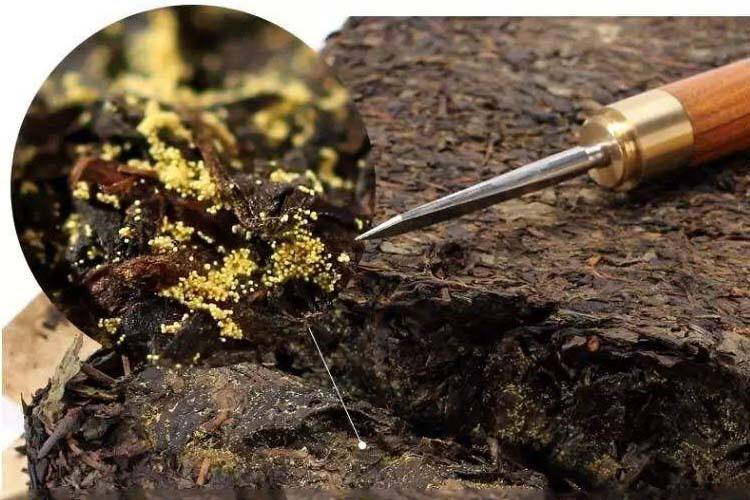中国茶叶之花-金花(冠突散囊菌)的功效
茶叶中的“金花”指的就是安化黑茶茯砖茶中的优势菌种—冠突散囊菌,这个名字非常富贵,也很金贵。茯砖茶在黑茶中独具特色,而“金花”让茯砖茶不仅具有独特的风味口感,更具有神奇的保健功效。冠突散囊菌,是一种益生真菌。
它是茯砖茶加工过程中,在特定的温、湿度条件下,通过“发花”工艺长成的自然益生菌体,直接影响了茯砖茶的品质。其产生的黄色闭囊壳,均匀地附着在茯砖茶中,形似“米兰”。金花(冠突散囊菌)是中外微生物学家在地球上新发现不到30年的微生物,过去只在千年灵芝上偶然发现过。
冠突散囊菌命名和功效
西北少数民族对长满“金花”的黑茶有无比的热爱,到了“一天不喝则滞(胀),三天不喝则病”的地步。过去长期的游牧生活,多食牛羊肉和奶酪,“金花”茶有明显的消滞胀,利消化的作用,能平衡边疆人民的身体免疫系统。科学研究统计,冠突散囊菌丝体富含15种氨基酸,包括人体所有必需的氨基酸。“金花”菌是一种抑制作用极强的强势菌种,只要有他存在,其它杂菌就被抑制了。金花菌又被称为“霸王菌”。金花菌能有效抑制肠癌、胃癌和肝癌细胞的扩张。
茯砖茶中存在显著降脂减肥和降糖功能的特异成分,茯砖茶中独有两种新的活性物质—茯茶素A和茯茶素B。茯茶中的“金花”能有效地调节人体新陈代谢,并有较强的降脂、降压、调节糖类代谢的功效。
1987年,湖南农学院温琼英教授等对黑茶中的主要微生物做科学研究,重点分析了冠突散囊菌。她对该菌的子囊孢子进行了电镜观察并拍摄了照片,并请中国科学院齐祖同协助鉴定。齐祖同用英联邦真菌研究所的冠突曲霉模式菌株172280作了对比,认为此菌与模式菌株在培养特征和显微特征是一致的,他将此菌初步定为冠突曲霉。1990年俩人对该菌作了进一步研究,认为使用冠突曲霉这一名称与国际植物命名法规相抵触,正式将该菌种鉴定为冠突散囊菌。
发花过程中神奇的孢外酶
黑毛茶在“发花”过程中伴随着微生物的滋生出现了新的多酚氧化酶。而纤维素酶在“发花”的6至9天出现了一个大的跃升,并在第9天达到最大值。随着发花时间延长,酶活性有所下降,但至出烘的成品样中,酶活性仍维持较高水平,果胶酶的活性最大值出现在发花后的12天,但没有象多酚氧化酶和纤维素酶那样明显的起伏变化,而是一直处于较低水平。
在发花过程中的优势菌种冠突散囊菌无疑是这些孢外酶产生的主要因素。微生物的代谢是全能型的,在发花过程中,一方面把茶叶中的某些物质作为养分消耗以满足自身生长的需要,另一方面它又分泌各种物质到体外。黑茶发花过程中,确实存在多种微生物酶,诸如多酚氧化酶、纤维素酶和果胶酶等,该几种酶分别作用于茯砖茶中的多酚类物质的氧化、纤维素和果胶物质的分解,对黑茶品质形成产生了极其重要的作用。当然,不仅仅是这三种酶的作用,发花中的其它孢外酶的研究将进一步弄清它们与茯茶品质的关系。
黑茶经过加工后,游离氨基酸、茶多酚、黄酮类、咖啡碱、可溶性糖及水浸出物都有不同程度的下降,发花初期下降速度缓慢,在发花 6-10天的时期内下降幅度较大;经过发花后,茶多酚中的黄酮类下降51.52%;氨基酸降低了36.84%。咖啡碱是较为稳定的化合物,在加工过程中仅下降10.85,可溶性糖及水浸出物含量变化最小,分别只有5.9%和2.34%。黑茶在加工过程中,多酚类物质的转化主要是“金花”产生的孢外酶的酶促氧化、自动氧化和水解三种。
黑毛茶在发花过程中,由于微生物的大量繁殖,释放胞外酶催化多酚类氧化,儿茶素各组分发生氧化聚合,从而减少了黑茶的粗涩味,增加了醇和的滋味。
黑茶的风味:色、香、味
黑茶原料的香气成分有60种,发花以后有66种,发花期间,醛酮类比之前增加了3.2倍,萜烯类与芳环酵类增加1.7倍,脂肪醇类增加4.7倍…,其它芳香类物质均有增加,只有酚类减少4.7倍。表现出强火功香的杂环化合物和其它变化了的芳香物质组成了“菌花香”,成为黑茶的特殊香味。
冠突散囊菌等微生物的大量参与,形成了特有的菌花香,并由于这些微生物的作用以及在加工过程中的高温高湿作用,茶多酚的氧化、缩合、蛋白质和纤维素等大分子的分解,氨基酸、糖类、咖啡碱等各成分之间的聚合、缩合等一系列反应,形成了茯砖茶的品质风味。 氨基酸在茯砖茶加工过程中的下降、氨基酸与糖类发生的反应和转化,是黑茶香气成分的重要原因。
安化黑茶加工过程中,咖啡碱可与茶多酚的氧化产物,蛋白蛋等物质以氢健缔合方式形成络合物,而咖啡碱是茶叶中带苦味的成份之一,其含量减少,有利于茯砖茶苦涩味降低。
茯茶“发花”就是在一定的水热作用下,通过优势菌种--冠突散囊菌大量繁殖,形成孢外酶,并通过酶外酶和水热作用,与茶叶中的多酚化合物等成分聚合、分解,与微生物本身一道,形成了茯茶的特殊色、香、味、形。
以下是英文翻译版:
The "golden flower" in tea refers to the dominant fungus in Anhua dark tea fuzhuan tea -- Bursiella coronatum. This name is very rich and precious. Fuzhuan tea is unique in dark tea, and "golden flowers" make fuzhuan tea not only have unique flavor and taste, but also have magical health care effect. Cystaphyllum coronatum is a probiotic fungus.
In the process of fuzhuan tea, it is a natural probiotics grown through the "blooming" process under specific temperature and humidity conditions, which directly affects the quality of Fuzhuan tea. The yellow obturator shell, which is evenly attached to the fu Brick tea, looks like "Milan". Golden flower (Cystis coronolaris) is a microorganism newly discovered on earth less than 30 years ago by Chinese and foreign microbiologists, which was only accidentally discovered on ganoderma lucidum for 1,000 years in the past.
Nomenclature and efficacy of Cystis coronoid
Northwest minorities have great love for dark tea full of "golden flowers", to the point that "if you don't drink it for a day, you will lag (swelling), and if you don't drink it for three days, you will get sick". In the past long-term nomadic life, eating more beef, mutton and cheese, "golden flower" tea has an obvious effect of eliminating stagflation, beneficial digestion, and can balance the body immune system of frontier people. According to scientific statistics, mycelium of coronoid process is rich in 15 kinds of amino acids, including all essential amino acids of human body. "Golden flower" fungus is a strong strain of inhibition, as long as it is present, other miscellaneous bacteria are inhibited. Golden flower fungus is also known as "overlord fungus". C. aureus can effectively inhibit the expansion of colon cancer, stomach cancer and liver cancer cells.
There are special ingredients in Fuzhuan tea which can reduce fat and sugar significantly. There are two new active substances in fuzhuan tea -- fuzhuan A and Fuzhuan B. The "golden flower" in fu tea can effectively regulate human metabolism, and has a strong effect of reducing fat, blood pressure and sugar metabolism.
In 1987, Professor Wen Qiongying of Hunan Agricultural University and others conducted scientific research on the main microorganisms in dark tea, focusing on the analysis of Bursa coronatum. She observed and photographed ascospores of the bacterium with electron microscopy and asked Qi Zutong of the Chinese Academy of Sciences to assist in identification. Qi Zutong compared the model strain of Aspergillus coronoid 172280 from the Commonwealth Institute of Fungi, and believed that the culture characteristics and microscopic characteristics of this strain were consistent with the model strain. He initially identified this strain as Aspergillus coronoid. In 1990, they did further research on the bacteria, and decided that the use of the name Aspergillus coronoid was in conflict with the international plant naming regulations, and officially identified the bacteria as M. coronoid.
Amazing extraspinal enzymes in the flowering process
New polyphenol oxidase (PPO) appeared in the process of "blooming" of black tea with the breeding of microorganisms. However, cellulase showed a large jump from day 6 to 9 of "hair flower" and reached its maximum value on day 9. With the prolongation of hair time, the enzyme activity decreased, but it still maintained a high level in the baked samples. The maximum activity of pectinase appeared in 12 days after hair, but it remained at a low level without obvious fluctuation like polyphenol oxidase and cellulase.
The dominant species in the flowering process is undoubtedly the main factor for the production of these extracellular enzymes. Microbial metabolism is omnipotent. In the process of flower development, on the one hand, certain substances in tea are consumed as nutrients to meet the needs of their own growth, and on the other hand, they secrete various substances to the body. During the blooming process of dark tea, there are indeed a variety of microbial enzymes, such as polyphenol oxidase, cellulase and pectinase, which act on the oxidation of polyphenols and the decomposition of cellulose and pectinase in fu Brick tea, respectively, and play an extremely important role in the formation of dark tea quality. Of course, not only the function of these three enzymes, but also the study of other extraspinal enzymes in hair flowers will further clarify their relationship with the quality of fu tea.
After processing dark tea, free amino acids, tea polyphenols, flavonoids, caffeine, soluble sugar and water extract all decreased to varying degrees. The decrease rate was slow in the initial stage of flowering, and the decrease rate was larger in 6-10 days. After flowering, flavonoids in tea polyphenols decreased by 51.52%. Amino acids decreased by 36.84%. Theine was a relatively stable compound, which only decreased by 10.85 in the process of processing. The contents of soluble sugar and water extract changed the least, only 5.9% and 2.34%, respectively. In the process of processing dark tea, polyphenols are mainly transformed into three kinds of extracellular enzymes produced by "golden flower" : enzymatic oxidation, automatic oxidation and hydrolysis.
In the blooming process of black tea, due to the mass propagation of microorganisms, the release of extracellular enzymes catalyzed the oxidation of polyphenols, and the oxidation polymerization of various components of catechins, thus reducing the rough taste of black tea and increasing the mellow taste.
Flavor of dark tea: color, aroma and taste
There are 60 kinds of aroma components of dark tea raw materials, and 66 kinds of aroma components after flowering. During the flowering period, aldehydes and ketones increase by 3.2 times, terpenes and aromatic cycloleavens increase by 1.7 times, fatty alcohols increase by 4.7 times... , all other aromatic substances increased except phenols, which decreased by 4.7 times. Heterocyclic compounds that exhibit a strong fire aroma and other aromatic substances that change form the "fungus fragrance" that is the characteristic aroma of dark tea.
Coronoid process scattered sac fungi and microbes involved in a lot, formed a unique fragrance, and as a result of the action of these microbes and the function of the high temperature and high humidity in the process, the oxidation of tea polyphenols, condensation and large molecules such as proteins and cellulose decomposition, between various components such as amino acid, sugar, caffeine a series of reactions such as polymerization, condensation, formed to the quality of the brick tea flavor to eight. The decline of amino acids in the process of fu Brick tea, the reaction and transformation between amino acids and sugars, are the important reasons for the aroma components of dark tea.
In the process of anhua dark tea, theine can form complex with oxidized products of tea polyphenols, protein eggs and other substances in the form of hydrogen association. Theine is one of the bitter ingredients in tea, and the reduction of its content is conducive to the reduction of bitter taste of Fu Brick tea.
The "blooming" of Fu tea is that under the action of certain hydrothermal, the dominant bacteria -- cystaphylococcus corundum prolifies to form extraspinal enzymes, and through the action of extraspinal enzymes and hydrothermal, the polyphenol compounds and other components in tea are aggregated and decomposed, together with the microorganism itself, forming the special color, fragrance, taste and shape of fu tea.
参考文献:
- 我的微信
- 微信扫一扫
-

- 我的微信公众号
- 微信扫一扫
-





评论